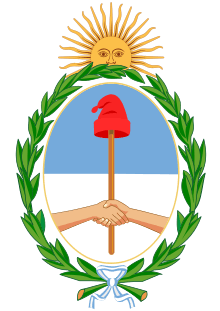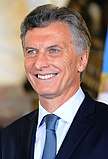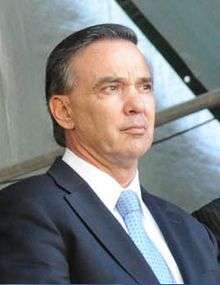2019 Argentine general election
General elections were held in Argentina on 27 October 2019, to elect the president of Argentina, members of the national congress and the governors of most provinces.[2] Former Cabinet Chief Alberto Fernández of Frente de Todos defeated incumbent president Mauricio Macri of Juntos por el Cambio, exceeding the threshold to win the presidency in a single round. Macri became the first incumbent president in Argentine history to be defeated in his reelection bid.
| |||||||||||||||||||||||||||||||||||||
| Opinion polls | |||||||||||||||||||||||||||||||||||||
| Registered | 33,858,733 | ||||||||||||||||||||||||||||||||||||
|---|---|---|---|---|---|---|---|---|---|---|---|---|---|---|---|---|---|---|---|---|---|---|---|---|---|---|---|---|---|---|---|---|---|---|---|---|---|
| Turnout | 81.31% | ||||||||||||||||||||||||||||||||||||
| |||||||||||||||||||||||||||||||||||||
.png) | |||||||||||||||||||||||||||||||||||||
| |||||||||||||||||||||||||||||||||||||
 |
|---|
| This article is part of a series on the politics and government of Argentina |
|
|
Legislative
|
|
|
|
|
|
Electoral system
The election of the president was conducted under the ballotage system, a modified version of the two-round system. A candidate can win the presidency in a single round by either winning 45% of the vote, or if they win 40% of the vote while finishing 10 percentage points ahead of the second-place candidate. If no candidate meets either threshold, a runoff takes place between the top two candidates.[3] Voting is compulsory for citizens between 18 and 70 years old.[4] Suffrage was also extended to 16- and 17-year-olds, though without compulsory voting.[5]
There are a total of 257 seats of the Chamber of Deputies. They are elected from 24 electoral districts–the 23 provinces, plus the federal district of Buenos Aires, which elects its own executive and legislature and is represented in the national Congress like all other provinces.[6] The number of seats are distributed in relation to the population of the province. One-third of the seats in the Chamber of Deputies are reserved for women. The 130 seats of the Chamber of Deputies up for election were elected from 24 multi-member constituencies based on the 23 provinces and Buenos Aires. Seats were allocated using the D'Hondt method of proportional representation, with an electoral threshold of 3%.[4]
The 24 seats in the Senate up for election were elected in three-seat constituencies using the closed list system. Each district is represented by three senatorial seats. Each party is allowed to register up to two candidates; one of those registered must be female. The party receiving the most votes wins two seats, and the second-placed party won one.[7] The third senatorial seat was established in the Constitution of 1994 in order to better represent the largest minority in each district.
Congress


Chamber of Deputies
The 257 members of the Chamber of Deputies are elected by proportional representation in 24 multi-member constituencies based on the provinces (plus the City of Buenos Aires). Seats are allocated using the d'Hondt method with a 3% electoral threshold. In this election, 130 of the 257 seats are up for renewal for a 4-year term.
| Province | Total seats |
Seats at stake |
|---|---|---|
| Buenos Aires | 70 | 35 |
| Buenos Aires City | 25 | 12 |
| Catamarca | 5 | 2 |
| Chaco | 7 | 3 |
| Chubut | 5 | 3 |
| Córdoba | 18 | 9 |
| Corrientes | 7 | 4 |
| Entre Ríos | 9 | 4 |
| Formosa | 5 | 3 |
| Jujuy | 6 | 3 |
| La Pampa | 5 | 2 |
| La Rioja | 5 | 3 |
| Mendoza | 10 | 5 |
| Misiones | 7 | 4 |
| Neuquén | 5 | 2 |
| Río Negro | 5 | 3 |
| Salta | 7 | 4 |
| San Juan | 6 | 3 |
| San Luis | 5 | 2 |
| Santa Cruz | 5 | 2 |
| Santa Fe | 19 | 10 |
| Santiago del Estero | 7 | 4 |
| Tierra del Fuego | 5 | 3 |
| Tucumán | 9 | 5 |
| Total | 257 | 130 |
Senate
The 72 members of the Senate are elected in the same 24 constituencies, with three seats in each. The party receiving the most votes in each constituency wins two seats, with the third seat awarded to the second-placed party. The 2019 elections will see one-third of Senators renewed, with eight provinces electing three Senators for a 6-year term; Buenos Aires City, Chaco, Entre Ríos, Neuquén, Río Negro, Salta, Santiago del Estero and Tierra del Fuego.
Confirmed candidates
The following candidates have successfully registered their nominations before the limit date of 22 June 2019.[8][9]
| Presidential candidate (political party) |
Vice-Presidential candidate (political party) |
Coalition | Coalition parties | Presidential candidate prior political offices | |||||
|---|---|---|---|---|---|---|---|---|---|
| Mauricio Macri (PRO) |
 |
Miguel Ángel Pichetto (PJ) |
 |
 |
|
President of Argentina (since 2015) Chief of Government of Buenos Aires (2007–2015) | |||
| Alberto Fernández (PJ) |
 |
Cristina Fernández de Kirchner (PJ) |
.jpg) |
 |
|
Chief of the Cabinet of Ministers (2003–2008) | |||
| Roberto Lavagna (Independent) |
.png) |
Juan Manuel Urtubey (PJ) |
.jpg) |
Federal Consensus |
|
Minister of Economy and Production (2003–2005) | |||
| Nicolás del Caño (PTS) |
 |
Romina Del Plá (PO) |
 |
 |
|
National Deputy from Buenos Aires (since 2017) | |||
| José Luis Espert (PL) |
 |
Luis Rosales (PL) |
 |
|
None (economist and professor) | ||||
| Alejandro Biondini (BV) |
 |
Enrique Venturino (BV) |
Patriotic Front |
|
None (founder and president of Bandera Vecinal) | ||||
| Manuela Castañeira (Nuevo MAS) |
.jpg) |
Eduardo Mulhall (Nuevo MAS) |
 |
None (sociologist) | |||||
| Juan José Gómez Centurión (NOS) |
.jpg) |
Cynthia Hotton (Valores para mi País) |
 |
NOS | Vice-President of the Bank of the Argentine Nation (2017–2019) | ||||
| José Antonio Romero Feris (PAN) |
 |
Guillermo Sueldo (PAN) |
 |
National Senator for Corrientes (1987–2001) Governor of Corrientes (1983–1987) | |||||
| Raúl Humberto Albarracín (Movimiento de Acción Vecinal) |
Sergio Darío Pastore (Movimiento de Acción Vecinal) |
Provincial legislator of Córdoba (2007–2011) | |||||||
Opinion polls
Results
Primary elections
Open primary elections for the Presidency were held nationwide on 11 August. With this system, all parties run primary elections on a single ballot. All parties must take part in it, both the parties with internal factions and parties with a single candidate list. Citizens may vote for any candidate of any party, but may only cast a single vote. The most voted candidate of parties gaining 1.5% or higher of the valid votes advances to the general election.
Fernández came top with 47.8% of the vote, with Macri trailing behind with 31.8%. Lavagna, del Caño, Gómez Centurión and Espert all received enough valid votes to participate in the general election.
| Party | Presidential candidate | Running mate | Votes | % | |
|---|---|---|---|---|---|
| Everyone's Front | Alberto Fernández | Cristina Fernández de Kirchner | 12,205,938 | 47.79 | |
| Together for Change | Mauricio Macri | Miguel Ángel Pichetto | 8,121,689 | 31.80 | |
| Federal Consensus | Roberto Lavagna | Juan Manuel Urtubey | 2,081,315 | 8.15 | |
| Workers' Left Front – Unity | Nicolás del Caño | Romina del Plá | 723,147 | 2.83 | |
| NOS Front | Juan José Gómez Centurión | Cynthia Hotton | 670,162 | 2.62 | |
| Unite for Liberty and Dignity | José Luis Espert | Luis Rosales | 550,593 | 2.16 | |
| New Movement for Socialism | Manuela Castañeira | Eduardo Mulhall | 179,461 | 0.70 | |
| Patriotic Front | Alejandro Biondini | Enrique Venturino | 58,944 | 0.23 | |
| Neighborhood Action Movement | Raúl Albarracín | Sergio Pastore | 36,411 | 0.14 | |
| National Autonomist Party | José Antonio Feris | Guillermo Sueldo | 32,722 | 0.13 | |
| Blank votes | 882,659 | 3.46 | |||
| Invalid votes | 318,009 | – | |||
| Total | 25,861,050 | 100 | |||
| Registered voters/turnout | 33,871,832 | 76.35 | |||
| Source: Poder Judicial de la Nación | |||||
President
| Candidate | Running mate | Party | Votes | % | |
|---|---|---|---|---|---|
| Alberto Fernández | Cristina Fernández de Kirchner | Everyone's Front | 12,945,990 | 48.24 | |
| Mauricio Macri | Miguel Ángel Pichetto | Together for Change | 10,811,345 | 40.28 | |
| Roberto Lavagna | Juan Manuel Urtubey | Federal Consensus | 1,649,315 | 6.14 | |
| Nicolás del Caño | Romina Del Plá | Workers' Left Front – Unity | 579,197 | 2.16 | |
| Juan José Gómez Centurión | Cynthia Hotton | NOS Front | 457,955 | 1.71 | |
| José Luis Espert | Luis Rosales | Unite for Liberty and Dignity | 394,206 | 1.47 | |
| Blank/invalid votes | 692,847 | – | |||
| Total | 27,530,855 | 100 | |||
| Registered voters/turnout | 33,858,733 | 81.31 | |||
| Source: Resultados | |||||
Fernández owed his victory mostly to Buenos Aires Province swinging over dramatically to support him; he carried it by over 1.6 million votes over Macri, accounting for almost all of his nationwide margin of 2.1 million votes. By comparison, Daniel Scioli only carried the province by 219,000 votes in 2015.
Results by district
| Province | Fernández/Fernández | Macri/Pichetto | Lavagna/Urtubey
(Consenso Federal) |
Del Caño/del Plá
(FIT–U) |
Gómez Centurión/Hotton
(NOS) |
Espert/Rosales
(UNITE) |
Blanks/Invalid | Turnout | ||||||||
|---|---|---|---|---|---|---|---|---|---|---|---|---|---|---|---|---|
| Votes | % | Votes | % | Votes | % | Votes | % | Votes | % | Votes | % | Votes | % | Votes | % | |
| Buenos Aires | 5.294.879 | 52.20% | 3.640.552 | 35.89% | 638.990 | 6.30% | 273.495 | 2.70% | 150.067 | 1.48% | 145.743 | 1.43% | 230.767 | 2.22% | 10.374.493 | 82.19% |
| Federal Capital | 719.655 | 35.46% | 1.068.134 | 52.64% | 130.475 | 6.43% | 59.066 | 2.91% | 13.863 | 0.68% | 38.013 | 1.87% | 46.228 | 2.23% | 2.075.434 | 76.85% |
| Catamarca | 132.590 | 56.66% | 79.568 | 34.00% | 13.197 | 5.64% | 3.508 | 1.50% | 2.136 | 0.91% | 3.011 | 1.29% | 24.941 | 9.63% | 258.951 | 81.04% |
| Chaco | 404.758 | 55.73% | 258.432 | 35.58% | 27.636 | 3.81% | 6.986 | 0.96% | 20.617 | 2.84% | 7.856 | 1.08% | 11.370 | 1.54% | 737.655 | 77.61% |
| Chubut | 174.726 | 52.42% | 97.837 | 29.35% | 25.357 | 7.61% | 13.117 | 3.94% | 14.253 | 4.28% | 8.029 | 2.40% | 14.289 | 4.11% | 347.608 | 77.78% |
| Córdoba | 666.445 | 29.31% | 1.394.104 | 61.31% | 113.734 | 5.00% | 37.612 | 1.65% | 31.869 | 1.40% | 30.213 | 1.33% | 68.489 | 2.93% | 2.342.466 | 79.01% |
| Corrientes | 354.968 | 51.19% | 290.690 | 41.92% | 21.658 | 3.12% | 6.522 | 0.94% | 12.515 | 1.80% | 7.044 | 1.02% | 13.427 | 1.90% | 706.824 | 80.75% |
| Entre Ríos | 390.587 | 44.37% | 391.495 | 44.47% | 55.030 | 6.25% | 14.504 | 1.65% | 14.647 | 1.66% | 14.111 | 1.60% | 14.576 | 1.63% | 894.950 | 80.59% |
| Formosa | 229.774 | 65.21% | 100.280 | 28.46% | 11.057 | 3.14% | 3.112 | 0.88% | 5.334 | 1.51% | 2.797 | 0.79% | 5.137 | 1.44% | 357.491 | 77.75% |
| Jujuy | 207.120 | 46.19% | 186.104 | 41.50% | 26.835 | 5.98% | 9.214 | 2.05% | 10.512 | 2.34% | 8.617 | 1.92% | 8.714 | 1.91% | 457.116 | 81.79% |
| La Pampa | 115.095 | 50.07% | 86.744 | 37.74% | 15.137 | 6.59% | 4.727 | 2.06% | 4.676 | 2.03% | 3.471 | 1.51% | 3.665 | 1.57% | 233.515 | 81.25% |
| La Rioja | 85.779 | 47.37% | 80.462 | 44.43% | 7.844 | 4.33% | 2.127 | 1.17% | 2.087 | 1.15% | 2.801 | 1.55% | 52.964 | 22.63% | 234.064 | 80.78% |
| Mendoza | 435.313 | 37.83% | 576.493 | 50.10% | 75.448 | 6.56% | 26.315 | 2.29% | 22.715 | 1.97% | 14.370 | 1.25% | 23.902 | 2.03% | 1.174.556 | 81.10% |
| Misiones | 417.752 | 57.71% | 245.254 | 33.88% | 24.451 | 3.38% | 6.704 | 0.93% | 21.239 | 2.93% | 8.537 | 1.18% | 18.551 | 2.50% | 742.488 | 79.90% |
| Neuquén | 194.158 | 47.75% | 151.698 | 37.31% | 25.621 | 6.30% | 15.205 | 3.74% | 11.742 | 2.89% | 8.166 | 2.01% | 20.127 | 4.72% | 426.717 | 84.23% |
| Río Negro | 247.664 | 57.23% | 123.674 | 28.58% | 27.483 | 6.35% | 11.252 | 2.60% | 14.173 | 3.28% | 8.482 | 1.96% | 19.431 | 4.30% | 452.159 | 80.35% |
| Salta | 374.369 | 48.82% | 266.406 | 34.74% | 82.358 | 10.74% | 13.625 | 1.78% | 16.635 | 2.17% | 13.378 | 1.74% | 17.608 | 2.24% | 784.379 | 76.11% |
| San Juan | 242.060 | 53.01% | 160.449 | 35.14% | 33.004 | 7.23% | 6.928 | 1.52% | 8.388 | 1.84% | 5.759 | 1.26% | 8.341 | 1.79% | 464.929 | 82.44% |
| San Luis | 129.118 | 41.68% | 139.479 | 45.03% | 20.954 | 6.76% | 7.171 | 2.32% | 7.683 | 2.48% | 5.354 | 1.73% | 8.076 | 2.54% | 317.835 | 81.53% |
| Santa Cruz | 108.323 | 59.77% | 51.183 | 28.24% | 9.123 | 5.03% | 6.032 | 3.33% | 5.171 | 2.85% | 1.402 | 0.77% | 7.649 | 4.05% | 188.883 | 74.73% |
| Santa Fe | 920.202 | 42.68% | 937.611 | 43.49% | 193.603 | 8.98% | 30.862 | 1.43% | 33.247 | 1.54% | 40.353 | 1.87% | 43.662 | 1.99% | 2.199.540 | 79.48% |
| Santiago del Estero | 451.082 | 74.95% | 110.525 | 18.37% | 20.103 | 3.34% | 5.755 | 0.96% | 9.220 | 1.53% | 5.123 | 0.85% | 9.924 | 1.62% | 611.732 | 80.45% |
| Tierra del Fuego | 57.887 | 56.93% | 26.529 | 26.09% | 7.785 | 7.66% | 2.760 | 2.71% | 3.925 | 3.86% | 2.803 | 2.76% | 3.208 | 3.06% | 104.897 | 75.88% |
| Tucumán | 591.686 | 57.76% | 347.642 | 33.94% | 42.432 | 4.14% | 12.598 | 1.23% | 21.241 | 2.07% | 8.773 | 0.86% | 17.801 | 1.71% | 1.042.173 | 82.84% |
| Total | 12.945.990 | 48.24% | 10.811.345 | 40.28% | 1.649.315 | 6.14% | 579.197 | 2.16% | 457.955 | 1.71% | 394.206 | 1.47% | 692.847 | 2.52% | 27.530.855 | 81.31% |
Chamber of Deputies
| Party | Votes | % | Seats | +/– | ||||
|---|---|---|---|---|---|---|---|---|
| Total before |
Not up |
Won | Total after | |||||
| Everyone's Front | 11,359,508 | 45.50 | 53 | 64 | 120 | |||
| Together for Change | 10,020,835 | 40.14 | 63 | 56 | 116 | |||
| Federal Consensus | 1,466,881 | 5.88 | 3 | 3 | 10 | |||
| Civic Front for Santiago | 326,566 | 1.26 | 5 | 0 | 3 | (TODOS) | ||
| We Do for Córdoba | 377,844 | 1.51 | 0 | 0 | 1 | 1 | ||
| Front for the Renewal of Concord | 191,757 | 0.77 | 5 | 2 | 1 | (TODOS) | ||
| Together We Are Río Negro | 121,478 | 0.49 | 0 | 0 | 1 | 1 | ||
| Let's All Live Better | 17,992 | 0.07 | 0 | 0 | 1 | 1 | ||
| Others parties | 1,098,595 | 4.38 | 0 | 3 | ||||
| Invalid/blank votes | – | – | – | – | – | – | ||
| Total | 100 | 257 | 127 | 130 | 257 | - | ||
| Registered voters / turnout | 32,890,049 | – | – | – | – | – | ||
| Source: | ||||||||
Senate
| Party | Votes | % | Seats | +/– | ||||
|---|---|---|---|---|---|---|---|---|
| Total before |
Not up |
Won | Total after | |||||
| Everyone's Front | 13 | 36 | ||||||
| Together for Change | 8 | 28 | ||||||
| Civic Front for Santiago | 328,627 | 2 | 2 | |||||
| Together We Are Río Negro | 153,338 | 0 | 0 | 1 | 1 | |||
| Others parties | 0 | |||||||
| Invalid/blank votes | – | – | – | – | – | – | ||
| Total | 100 | 72 | 48 | 24 | 72 | - | ||
| Registered voters / turnout | – | – | – | – | – | |||
| Source: | ||||||||
Provincial Elections
| Date | District | Offices | Winner | Runner-up |
|---|---|---|---|---|
| 10 March | Neuquén | Governor
Vice Governor 35 provincial deputies |
Omar Gutiérrez - Marcos Koopmann
(People's Neuquin Movement) (40,19 %) |
Ramón Rioseco - Darío Martínez
(Neuquin Front–Citizens' Unity) (25,93 %) |
| 7 April | Río Negro | Governor
Vice Governor 46 provincial deputies |
Arabela Carreras - Alejandro Palmieri
(Together we are Río Negro) (52,63 %) |
Martín Soria - Magdalena Odarda
(Front for Victory) (34,97 %) |
| 12 May | Córdoba | Governor
Vice Governor 70 provincial deputies |
Juan Schiaretti - Manuel Calvo
(We do for Córdoba) (57,38 %) |
Mario Negri - Héctor Baldassi
(Córdoba Changes) (18,85 %) |
| 19 May | La Pampa | Governor
Vice Governor 30 provincial deputies |
Sergio Ziliotto - Mariano Fernández
(Pampean Justicialist Front) (52,68 %) |
Daniel Kroneberger - Luis Evangelista
(Cambiemos La Pampa) (31,80 %) |
| 2 June | Misiones | Governor
Vice Governor 20 provincial deputies |
Oscar Herrera Ahuad - Carlos Omar Arce
(Front for the Renewal of Concord) (72,81 %) |
Humberto Schiavoni - Luis Mario Pastori
(Together for Change) (17,59 %) |
| San Juan | Governor
Vice Governor 36 provincial deputies |
Sergio Uñac - Roberto Gattoni
(Everyone Front) (55,84 %) |
Marcelo Orrego - Susana Laciar
(Front with You) (33,91 %) | |
| 9 June | Chubut | Governor
Vice Governor 27 provincial deputies |
Mariano Arcioni - Ricardo Sastre
(Chubut Ahead) (41,35 %) |
Carlos Linares - Claudia Bard
(Chubut Patriotic Front) (33,97 %) |
| Entre Ríos | Governor
Vice Governor 34 provincial deputies 17 provincial senators |
Gustavo Bordet - María Laura Stratta
(Believe Entre Ríos) (57,43 %) |
Atilio Benedetti - Gustavo Hein
(Cambiemos) (35,57 %) | |
| Jujuy | Governor
Vice Governor 24 provincial deputies |
Gerardo Morales - Carlos Haquim
(Change Jujuy) (43,76 %) |
Julio Ferreyra - Adrián Mendieta
(Justicialist Front) (32,77 %) | |
| Tucumán | Governor
Vice Governor 49 provincial deputies |
Juan Luis Manzur - Osvaldo Jaldo
(Justicialist Front for Tucumán) (51,86 %) |
Silvia Elías de Pérez - José Manuel Paz
(Let's Go Tucumán) (20,41 %) | |
| 16 June | Formosa | Governor
Vice Governor 15 provincial deputies |
Gildo Insfrán - Eber Wilson Solís
(Justicialist Party) (70,66 %) |
Adrián Bogado - Iván Nicolás Kaluk
(Formosan Broad Front) (28,89 %) |
| San Luis | Governor
Vice Governor 21 provincial deputies 5 provincial senators |
Alberto Rodríguez Saá - Eduardo Mones Ruiz
(Justicialist Unity) (42,34 %) |
Claudio Poggi - Enrique Ariel Ponce
(United San Luis) (34,54 %) | |
| Santa Fe | Governor
Vice Governor 50 provincial deputies 19 provincial senators |
Omar Perotti - Alejandra Rodenas
(Together Front) (42,31 %) |
Antonio Bonfatti - María Victoria Tejeda
(Progessive, Civic and Social Front) (37,91 %) | |
| Tierra del Fuego | Governor
Vice Governor 15 provincial deputies |
Gustavo Melella - Mónica Urquiza
(FORJA) (55,03 %) |
Rosana Bertone - Juan Carlos Arcando
(Fueguin Unity) (40,86 %) | |
| 11 August | Santa Cruz | Governor
Vice Governor 24 provincial deputies |
Alicia Kirchner - Eugenio Quiroga
(Santacruzean Accord) (58,59%) |
Eduardo Costa - Liliana Andrade
(To get out ahead) (32,03%) |
| 29 September | Mendoza | Governor
Vice Governor 24 provincial deputies 19 provincial senators |
Rodolfo Suárez - Mario Abed
(Change Mendoza) (51,63%) |
Anabel Fernández Sagasti - Jorge Tanus
(Choose Mendoza) (36,21%) |
| 13 October | Chaco | Governor
Vice Governor 16 provincial deputies |
Jorge Capitanich - Analía Rach Quiroga
(Chaquean Front) (49,32%) |
Carim Peche - Roy Nikisch
(We are all Chaco) (31,40%) |
| 27 October | Buenos Aires | Governor
Vice Governor 46 provincial deputies 23 provincial senators |
Axel Kicillof - Verónica Magario
(Everyone's Front) (52,28%) |
María Eugenia Vidal - Daniel Salvador
(Together for Change) (38,39%) |
| Catamarca | Governor
Vice Governor 20 provincial deputies 8 provincial senators |
Raúl Jalil - Rubén Dusso
(Everyone's Front) (60,40%) |
Roberto Gómez - Lía Quiroga
(Together for Change) (33,46%) | |
| Buenos Aires City | Chief of Government
Vice Chief of Government 30 legislators |
Horacio Rodríguez Larreta - Diego Santilli
(Together for Change) (55,90%) |
Matías Lammens - Gisela Marziotta
(Everyone's Front) (35,06%) | |
| La Rioja | Governor
Vice Governor 18 provincial deputies |
Ricardo Quintela - Florencia López
(Everyone's Front) (40,84%) |
Julio Martínez - Teresita Luna
(Together for La Rioja) (27,90%) | |
| 10 November | Salta | Governor
Vice Governor 30 provincial deputies 11 provincial senators |
Gustavo Sáenz - Antonio Marocco
(Sáenz Governor Front) (53,85%) |
Sergio Leavy - Emiliano Estrada
(Everyone's Front) (26,00%) |
References
- "Calendario electoral 2019: las fechas del cronograma, provincia por provincia". La Nación (in Spanish). Retrieved 24 June 2019.
- "Reuters TV - Live". Reuters TV. Archived from the original on October 28, 2019. Retrieved Oct 29, 2019.
- David Hodari (23 October 2015). "Argentina elections 2015: a guide to the parties, polls and electoral system". The Guardian. Retrieved 3 November 2015.
- Chamber of Deputies: Electoral system Archived 31 October 2013 at the Wayback Machine IPU
- Voto de los Jóvenes de 16 y 17 años0 Archived 2017-03-30 at the Wayback Machine Camara Nacional Electoral
- Regúnaga, Carlos (22 October 2007). "CSIS Hemisphere Focus" (PDF). The Argentine Elections: Systems and Candidates. Retrieved 22 April 2016.
- Argentine Republic: Election for Senado (Senate) IFES
- "Cierre de listas electorales: todos los candidatos para las elecciones 2019". La Nación (in Spanish). Retrieved 24 June 2019.
- "Mirá las boletas de los principales candidatos en Argentina". Infobae (in Spanish). 23 June 2019. Retrieved 24 June 2019.